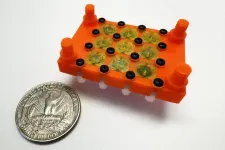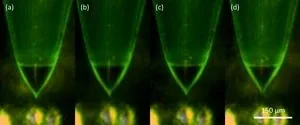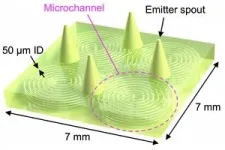(Press-News.org) CAMBRIDGE, MA – An electrospray engine applies an electric field to a conductive liquid, generating a high-speed jet of tiny droplets that can propel a spacecraft. These miniature engines are ideal for small satellites called CubeSats that are often used in academic research.
Since electrospray engines utilize propellant more efficiently than the powerful, chemical rockets used on the launchpad, they are better suited for precise, in-orbit maneuvers. The thrust generated by an electrospray emitter is tiny, so electrospray engines typically use an array of emitters that are uniformly operated in parallel.
However, these multiplexed electrospray thrusters are typically made via expensive and time-consuming semiconductor cleanroom fabrication, which limits who can manufacture them and how the devices can be applied.
To help break down barriers to space research, MIT engineers have demonstrated the first fully 3D-printed, droplet-emitting electrospray engine. Their device, which can be produced rapidly and for a fraction of the cost of traditional thrusters, uses commercially accessible 3D printing materials and techniques. The devices could even be fully made in orbit, as 3D printing is compatible with in-space manufacturing.
By developing a modular process that combines two 3D printing methods, the researchers overcame the challenges involved in fabricating a complex device comprised of macroscale and microscale components that must work together seamlessly.
Their proof-of-concept thruster comprises 32 electrospray emitters that operate together, generating a stable and uniform flow of propellant. The 3D-printed device generated as much or more thrust than existing droplet-emitting electrospray engines. With this technology, astronauts might quickly print an engine for a satellite without needing to wait for one to be sent up from Earth.
“Using semiconductor manufacturing doesn’t match up with the idea of low-cost access to space. We want to democratize space hardware. In this work, we are proposing a way to make high-performance hardware with manufacturing techniques that are available to more players,” says Luis Fernando Velásquez-García, a principal research scientist in MIT’s Microsystems Technology Laboratories (MTL) and senior author of a paper describing the thrusters, which appears in Advanced Science.
He is joined on the paper by lead author Hyeonseok Kim, an MIT graduate student in mechanical engineering.
A modular approach
An electrospray engine has a reservoir of propellant that flows through microfluidic channels to a series of emitters. An electrostatic field is applied at the tip of each emitter, triggering an electrohydrodynamic effect that shapes the free surface of the liquid into a cone-shaped meniscus that ejects a stream of high-speed charged droplets from its apex, producing thrust.
The emitter tips need to be as sharp as possible to attain the electrohydrodynamic ejection of propellant at a low voltage. The device also requires a complex hydraulic system to store and regulate the flow of liquid, efficiently shuttling propellant through microfluidic channels.
The emitter array is composed of eight emitter modules. Each emitter module contains an array of four individual emitters that must work in unison, forming a larger system of interconnected modules.
“Using a one-size-fits-all fabrication approach doesn’t work because these subsystems are at different scales. Our key insight was to blend additive manufacturing methods to achieve the desired outcomes, then come up with a way to interface everything so the parts work together as efficiently as possible,” Velásquez-García says.
To accomplish this, the researchers utilized two different types of vat photo polymerization printing (VPP). VPP involves shining light onto a photosensitive resin, which solidifies to form 3D structures with smooth, high-resolution features.
The researchers fabricated the emitter modules using a VPP method called two-photon printing. This technique utilizes a highly focused laser beam to solidify resin in a precisely defined area, building a 3D structure one tiny brick, or voxel, at a time. This level of detail enabled them to produce extremely sharp emitter tips and narrow, uniform capillaries to carry propellant.
The emitter modules are fitted into a rectangular casing called a manifold block, which holds each in place and supplies the emitters with propellant. The manifold block also integrates the emitter modules with the extractor electrode that triggers propellant ejection from the emitter tips when a suitable voltage is applied. Fabricating the larger manifold block using two-photon printing would be infeasible because of the method’s low throughput and limited printing volume.
Instead, the researchers used a technique called digital light processing, which utilizes a chip-sized projector to shine light into the resin, solidifying one layer of the 3D structure at a time.
“Each technology works very well at a certain scale. Combining them, so they work together to produce one device, lets us take the best of each method,” Velásquez-García says.
Propelling performance
But 3D printing the electrospray engine components is only half the battle. The researchers also conducted chemical experiments to ensure the printing materials were compatible with the conductive liquid propellant. If not, the propellant might corrode the engine or cause it to crack, which is undesirable for hardware meant for long-term operation with little to no maintenance.
They also developed a method to clamp the separate parts together in a way that avoids misalignments which could hamper performance and ensures the device remains watertight.
In the end, their 3D-printed prototype was able to generate thrust more efficiently than larger, more expensive chemical rockets and outperformed existing droplet electrospray engines.
The researchers also investigated how adjusting the pressure of propellant and modulating the voltage applied to the engine affected the flow of droplets. Surprisingly, they achieved a wider range of thrust by modulating the voltage. This could eliminate the need for a complex network of pipes, valves, or pressure signals to regulate the flow of liquid, leading to a lighter, cheaper electrospray thruster that is also more efficient.
“We were able to show that a simpler thruster can achieve better results,” Velásquez-García says.
The researchers want to continue exploring the benefits of voltage modulation in future work. They also want to fabricate denser and larger arrays of emitter modules. In addition, they may explore the use of multiple electrodes to decouple the process of triggering of the electrohydrodynamic ejection of propellant from setting up the shape and speed of the emitted jet. In the long run, they also hope to demonstrate a CubeSat that utilizes a fully 3D-printed electrospray engine during its operation and deorbiting.
###
This research is funded, in part, by a MathWorks fellowship and the NewSat Project, and was carried out, in part, using MIT.nano facilities.
END
MIT engineers develop a fully 3D-printed electrospray engine
Ideal for propelling tiny satellites, the lightweight devices could be produced on board a spacecraft and cost much less than traditional thrusters
2025-02-13
ELSE PRESS RELEASES FROM THIS DATE:
Speculum exams unnecessary for HPV screening
2025-02-13
Genital human papillomavirus is the most common sexually transmitted infection in the United States and is thought to be responsible for more than 99% of cervical cancers.
HPV screening usually entails a speculum-based exam, which is an uncomfortable experience for most patients, especially those who have physical disabilities.
In two studies, published in Preventive Medicine Reports and JAMA Network Open, University of Michigan researchers are the first to demonstrate in the U.S. that self-sampling is just as effective as speculum-based testing for HPV detection.
Most people who have HPV are usually unaware that they have it.
By ...
Reduced prediabetes in people who ate broccoli compound
2025-02-13
The chemical compound sulforaphane found in broccoli sprouts can be linked to improved blood sugar levels in prediabetes, a precursor to type 2 diabetes. This has been shown in a study conducted at the University of Gothenburg. The broccoli compound had a more significant effect on blood sugar levels in certain people.
Researchers at the University of Gothenburg have previously identified sulforaphane as an antidiabetic agent in type 2 diabetes. A patient study conducted in 2017 demonstrated significantly lower blood sugar in people with diabetes after they took large ...
Landmark atlas reveals how aging breast tissue shapes breast cancer risk
2025-02-13
Aging is a privilege, but it also brings risks—including an increased likelihood of developing age-related diseases including cancer. Researchers at The Jackson Laboratory (JAX) have created a landmark atlas of how healthy breast tissue ages, revealing key cellular, molecular, and genetic changes that may tip the balance toward breast cancer development. Their findings, published recently in Nature Aging, provide a valuable open-access resource for the scientific community to explore aging and its role in increased cancer risk.
Rewriting ...
SHEA supports key federal advisory committees
2025-02-13
The Society for Healthcare Epidemiology of America (SHEA) urges incoming Secretary of the U.S. Department of Health and Human Services, Robert F. Kennedy Jr., to resume the federal advisory committees for key health-related priority issues as provided under the Federal Advisory Committees Act. Federal advisory committees are an important aspect of the deliberative process for reviewing important scientific information among federal agencies and members of the public as new evidence becomes available. The ability for members ...
Neurologic complications of flu nearly 50 times greater for children with underlying neurologic conditions
2025-02-13
Many clinicians do not consider neurologic complications of the flu when discussing vaccination or treatment of influenza with families.
A recent study that explored the neurologic impact of flu in children aims to change that.
“Serious Neurologic Events with Seasonal Influenza in Young Children,” published in Academic Pediatrics, the official journal of the Academic Pediatric Association, looked at the population-based incidence of underrecognized influenza-associated serious neurologic events in children less than 5 years of age.
While serious neurologic complications are uncommon in young children, the study showed a much higher incidence, ...
Killing H5N1 in waste milk — an alternative to pasteurization
2025-02-13
Pasteurization is the only widely recognized method of killing H5N1, the virus that causes bird flu, in milk. However, pasteurization can be expensive and fewer than 50% of large dairy farms pasteurize waste milk.
Waste milk includes colostrum, the first milk after calving; milk from cows treated with antibiotics or other drugs; or any other factor that can make milk unsuitable and unsellable for human consumption. On farms, raw waste milk poses a potential risk of spreading avian flu, which so far has been confirmed ...
NTT Research and Harvard scientists optimize biohybrid ray development with machine learning
2025-02-13
The Harvard John A. Paulson School of Engineering and Applied Sciences (SEAS) and NTT Research, Inc., a division of NTT, announced the publication of research showing an application of machine-learning directed optimization (ML-DO) that efficiently searches for high-performance design configurations in the context of biohybrid robots. Applying a machine learning approach, the researchers created mini biohybrid rays made of cardiomyocytes (heart muscle cells) and rubber with a wingspan of about 10 mm that are approximately two times more efficient at swimming than those recently ...
Mapping connections in a neuronal network
2025-02-13
Harvard researchers have mapped and catalogued more than 70,000 synaptic connections from about 2,000 rat neurons, using a silicon chip capable of recording small yet telltale synaptic signals from a large number of neurons.
The research, published in Nature Biomedical Engineering, is a major advance in neuronal recording and may help bring scientists a step closer to drawing a detailed synaptic connection map of the brain.
Higher-order brain functions are believed to be derived from the ways brain ...
Study: Air pollution exposure late in pregnancy increases NICU admission risk
2025-02-13
BUFFALO, N.Y. – Air pollution caused by auto emissions, wildfires and other sources is problematic for many people. It’s of particular concern for pregnant people due to the impact pollutants can have on the fetus, especially in the final month before birth.
A new study from the University at Buffalo offers insight into air pollution’s effects during this vulnerable time by measuring neonatal intensive care unit (NICU) admissions and satellite-based air pollution data.
The researchers focused on common pollutants, such as nitrogen dioxide (NO2), which is caused primarily by the burning of fossil fuels in vehicles, industrial processes and power plants, and PM2.5, which ...
Engineers enable a drone to determine its position in the dark and indoors
2025-02-13
CAMBRIDGE, MA – In the future, autonomous drones could be used to shuttle inventory between large warehouses. A drone might fly into a semi-dark structure the size of several football fields, zipping along hundreds of identical aisles before docking at the precise spot where its shipment is needed.
Most of today’s drones would likely struggle to complete this task, since drones typically navigate outdoors using GPS, which doesn’t work in indoor environments. For indoor navigation, some drones ...
LAST 30 PRESS RELEASES:
Ticking time bomb: Some farmers report as many as 70 tick encounters over a 6-month period
Turning garden and crop waste into plastics
Scientists discover ‘platypus galaxies’ in the early universe
Seeing thyroid cancer in a new light: when AI meets label-free imaging in the operating room
Neutrophil-to-lymphocyte ratio may aid risk stratification in depressive disorder
2026 Seismological Society of America Annual Meeting
AI-powered ECG analysis offers promising path for early detection of chronic obstructive pulmonary disease, says Mount Sinai researchers
GIMM uncovers flaws in lab-grown heart cells and paves the way for improved treatments
Cracking the evolutionary code of sleep
Medications could help the aging brain cope with surgery, memory impairment
Back pain linked to worse sleep years later in men over 65, according to study
CDC urges ‘shared decision-making’ on some childhood vaccines; many unclear about what that means
New research finds that an ‘equal treatment’ approach to economic opportunity advertising can backfire
Researchers create shape-shifting, self-navigating microparticles
Science army mobilizes to map US soil microbiome
Researchers develop new tools to turn grain crops into biosensors
Do supervised consumption sites bring increased crime? Study suggests that’s a myth
New mass spec innovation could transform research
Maternal nativity, race, and ethnicity and infant mortality in the US
Migration-related trauma among asylum seekers exposed to the migrant protection protocols
Jupiter’s moon Europa has a seafloor that may be quiet and lifeless
SwRI upgrades nuclear magnetic resonance laboratory for pharmaceutical R&D
House sparrows in northern Norway can help us save other endangered animals
Crohn's & Colitis Foundation survey reveals more than 1/3 of young adults with IBD face step therapy insurance barriers
Tethered UAV autonomous knotting on environmental structures for transport
Decentralized social media platforms unlock authentic consumer feedback
American Pediatric Society announces Vanderbilt University School of Medicine as host institution for APS Howland Visiting Professor Program
Scientists discover first method to safely back up quantum information
A role for orange pigments in birds and human redheads
Pathways to net-zero greenhouse gas emissions for Southeast Asia
[Press-News.org] MIT engineers develop a fully 3D-printed electrospray engineIdeal for propelling tiny satellites, the lightweight devices could be produced on board a spacecraft and cost much less than traditional thrusters








